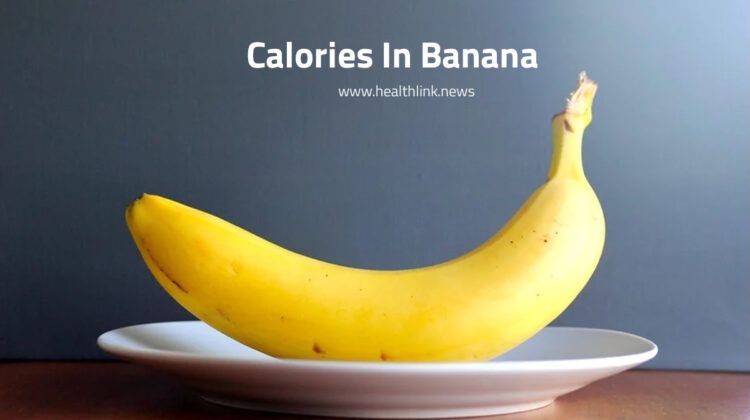How Many Calories Are in a Banana? Let’s Checkout

Bananas are the most famous fruit, and one cannot question it in terms of why. They are not only convenient but versatile at the same time. It is used as a staple ingredient all over the world. As we know that bananas are so full of nutrients and healthy to add to your diet but that does not mean you can consume as many bananas as you want because consuming too many bananas at the same time can be harmful. Let us see how to consume bananas.
Banana nutritional value
It is no wonder that the nutritional value of bananas makes them come out of the box. They are loaded with so many important nutrients and are a good source of manganese, Vitamins C & B6, and potassium.
Considering a fresh banana of 118 grams, it has the following amount of nutrients.
- Calories: 105
- Potassium: 12% of the DV
- Manganese: 16% of the DV
- Magnesium: 8% of the DV
- Fat: 0.3 grams
- Protein: 1 gram
- Carbs: 27 grams
- Fiber: 3 grams
- Vitamin C: 17% of the Daily Value (DV)
- Vitamin B6: 22% of the DV
Bananas are also known for reducing stress as they have plant compounds in them. Not only this, bananas reduce inflammation and the risk of severe diseases. It is recommended by the world health organization (WHO) to consume a minimum of five fruits and vegetables every day. Bananas are a whole fruit so inculcating them in your diet can actually improve your overall health.
Low fat and protein intensity
Bananas have a very low amount of fat and protein in them and most of the calorie that is present in banana comes from carbs. If we look at the total fat and protein value of bananas then also it comes out to be less than 8% as compared to the calorie content present in bananas. For proper functioning of the immune system, tissue repairing, muscle building, and breath health, protein is required in your body as it is the most structural component present in your body. What are fats? Fats are something that provides energy and help in absorbing nutrients that are fat-soluble and they play a major role in the production of hormones and brain health. But bananas lack these essential nutrients as they can’t hold these nutrients of their own. Before consuming banana as a routine snack make sure you consume it by pairing it up with healthy protein and fat like a handful of walnuts, boiled eggs, or peanut butter. It makes bananas more nutritionally balanced.
Too good to add in lifestyle
Consuming bananas is the healthiest addition to any diet but adding any food too much in a single shot is harmful including bananas. Though banana is not a high-calorie food if your banana eating habit is making you consume more calories than what your body requires, it will lead to unhealthy weight gain. 90% of the calories present in bananas come from carbs. Starch is the reason for carbs in green or unripe bananas because when the fruit ripens the starch in it converts into sugar and with time you are ready to eat your ripe banana but a big number of calories may come in due to sugar. Without balancing the fat and protein content, carbs are considered to be over-consumed as it levels up your blood sugar level and makes it difficult for people to manage who have diabetes or prediabetes. Moreover. Consuming a lot of bananas can lead to problems like nutritional deficiency which too when you consume food that does not have the nutrients that bananas are lacking like fat, protein, iron, calcium, and vitamin D.
How many bananas you should consume?
Maintaining balance is the key to a healthy lifestyle. Your body is a huge system with various complexities, to function properly it requires so many nutrients, and the best way to make sure that you are getting each and everything as per the requirement of your body is to divide your food and then consume it in small meals. As such, there is no defined number of bananas to consume until you are overeating them. To keep it under moderate intake you can consume one to two bananas in a day but do not forget to pair it up with fruits, vegetables, and nuts.
How many calories are in a banana?
The average count of a medium-sized banana contains 105 calories. However, the sizes of bananas vary which makes the calorie count different.
Here is some calories count of a standard-size of banana that will help you next time you eat it:
- Extra small (shorter than 6 inches, 81 grams): 72 calories (about 6 minutes of running)
- Small (6–7 inches, 101 grams): 90 calories (about 7 minutes of running)
- Medium (7–8 inches, 118 grams): 105 calories (about 8 minutes of running)
- Large (8–9 inches, 136 grams): 121 calories (about 10 minutes of running)
- Extra-large (9 inches or longer, 152 grams): 135 calories (about 11 minutes of running)
- Sliced (1 cup, 150 grams): 134 calories (about 11 minutes of running)
- Mashed (1 cup, 225 grams): 200 calories
Still, if these numbers do not convince you and make you confused then you can always estimate that an average banana contains about 100 calories (about 8 minutes of running).
About 93% of a banana’s calories come from carbs, 4% from protein, and 3% from fat.
Unripe (green) bananas contain more resistant starch
Banana is 90% carbs; however, the carb composition changes significantly during ripening.
The greener the banana is the more starch it contains with some resistant starch. The more it gets ripe the more starch gets converted to sugar. Unripe banana contains more level of starch than ripe ones. A fully ripe banana contains only 1% of resistant starch.
Now, what is resistance starch?
Resistant starch can be defined as a type of indigestible carbohydrate that functions like fiber in the body escaping digestion. When it reaches the colon, it is undigested that feeds friendly gut bacteria.
Once the resistant starch gets digested by bacteria they convert into gases and short-chain fatty acids (SCFAs), which are important for digestive health.
Then what our body does is that they absorb 95% of these SCFAs by the cells in the colon which then can be used by the body for energy.
Therefore, the calories produced will be lower by resistance starch than the regular carbs during digestion, they may be transformed into SCFAs that provide calories later.
Thus, we can say both kinds of bananas provide a similar count of calories.
Bananas contain many other beneficial nutrients
Bananas are known to be enriched with lots of nutrition containing a good amount of many vitamins and minerals.
One medium banana contains
Fiber: 3.1 grams
Vitamin B6: 25% of the DV
Vitamin C: 11% of the DV
Manganese: 14% of the DV
Potassium: 12% of the DV
Folate: 6% of the DV
Riboflavin (vitamin B2): 5% of the DV
Bananas are delicious and nutritious. They make an amazing, healthy, and low-calorie snack.
Bananas have a low glycemic index, but it depends on ripeness
What is a glycemic index?
Many people are unaware of a term called the glycemic index (GI). It is a measure of the quantity of food that soot up your blood sugar levels. When the food scores less than 55, then we call it low GI. When the score is 56–69, it is considered medium, and 70 or above is known to be high.
Some foods have simple sugars in them which speedily get absorbed containing a high GI value which causes a high rise in blood sugar levels. Consuming lots of high GI food can lead to gaining weight which can result in obesity, type 2 diabetes, heart disease, and stroke.
Keeping your blood sugar level is crucial for avoiding any complications. Consuming low GI foods will be beneficial in keeping your blood sugar level balanced. Banana has 90% of carbs which can spike your sugar level as it is known to be a high sugar fruit. Though, the GI score of bananas is 42-62 which puts it in the low to the medium category depending on how much ripe that banana is.
If you consume ripe bananas which means it will be having a higher GI than greener ones. When the banana gets ripe the sugar level also increases which leads to a rise in sugar level. Bananas usually release sugar slowly.
According to a study conducted for 4 weeks on type 2 diabetes and high cholesterol, which leads to eating a banana for breakfast that is 9 ounces (250 grams) remarkably reduced their fasting blood sugar and cholesterol levels (32Trusted Source).
If you consume bananas which is a low GI food might lead to weight loss making you feel full and stabilizing your blood sugar level.
